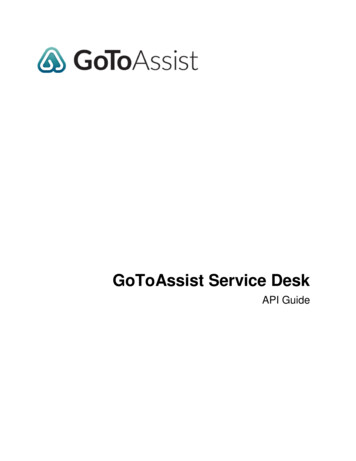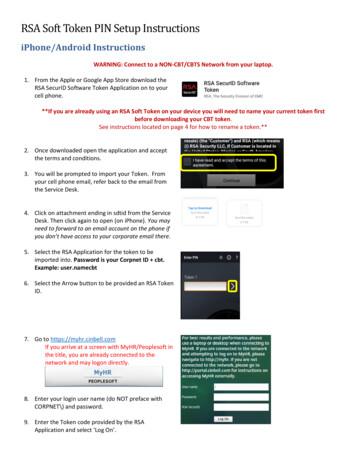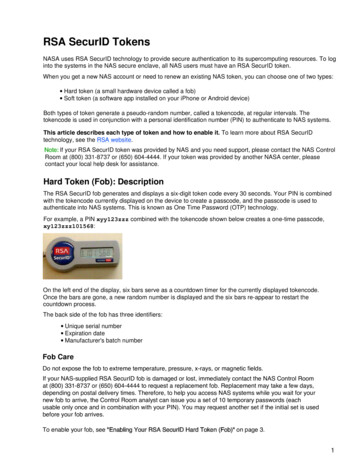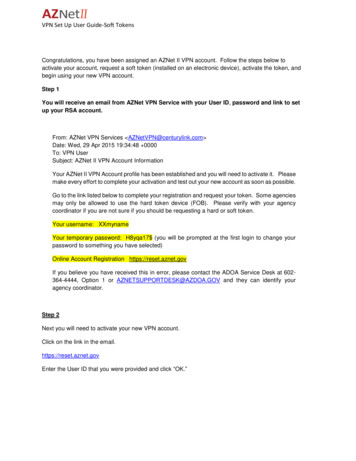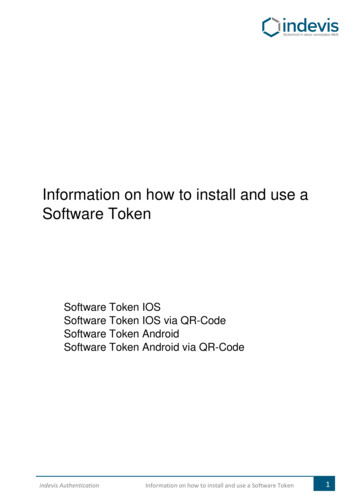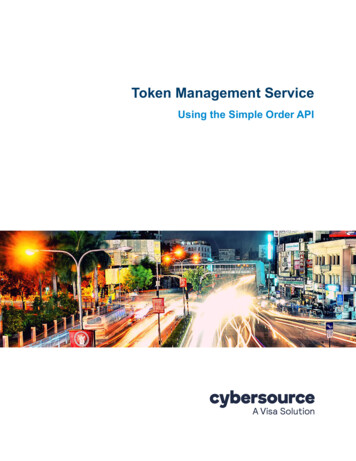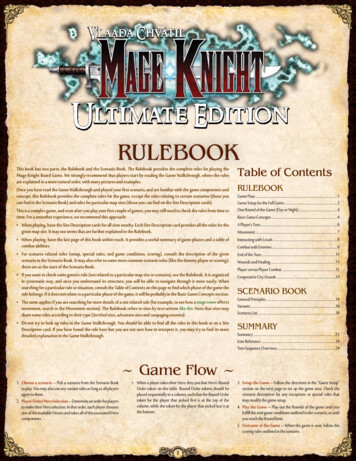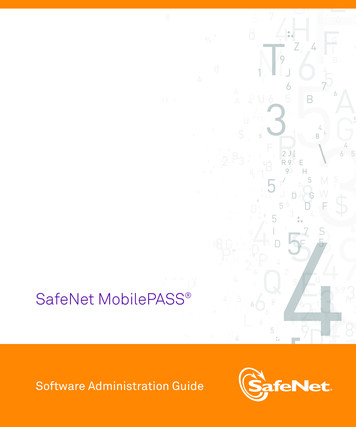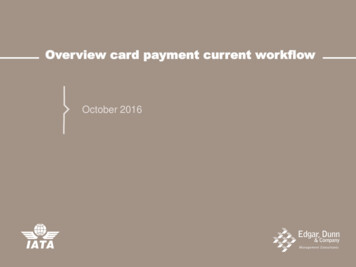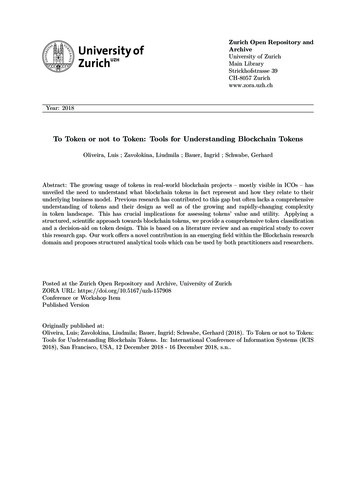
Transcription
Zurich Open Repository andArchiveUniversity of ZurichMain LibraryStrickhofstrasse 39CH-8057 Zurichwww.zora.uzh.chYear: 2018To Token or not to Token: Tools for Understanding Blockchain TokensOliveira, Luis ; Zavolokina, Liudmila ; Bauer, Ingrid ; Schwabe, GerhardAbstract: The growing usage of tokens in real-world blockchain projects – mostly visible in ICOs – hasunveiled the need to understand what blockchain tokens in fact represent and how they relate to theirunderlying business model. Previous research has contributed to this gap but often lacks a comprehensiveunderstanding of tokens and their design as well as of the growing and rapidly-changing complexityin token landscape. This has crucial implications for assessing tokens’ value and utility. Applying astructured, scientific approach towards blockchain tokens, we provide a comprehensive token classificationand a decision-aid on token design. This is based on a literature review and an empirical study to coverthis research gap. Our work offers a novel contribution in an emerging field within the Blockchain researchdomain and proposes structured analytical tools which can be used by both practitioners and researchers.Posted at the Zurich Open Repository and Archive, University of ZurichZORA URL: https://doi.org/10.5167/uzh-157908Conference or Workshop ItemPublished VersionOriginally published at:Oliveira, Luis; Zavolokina, Liudmila; Bauer, Ingrid; Schwabe, Gerhard (2018). To Token or not to Token:Tools for Understanding Blockchain Tokens. In: International Conference of Information Systems (ICIS2018), San Francisco, USA, 12 December 2018 - 16 December 2018, s.n.
To Token or not to Token: Understanding Blockchain TokensTo Token or not to Token: Tools forUnderstanding Blockchain TokensCompleted Research PaperLuis OliveiraUniversity of ZurichBinzmühlestrasse 148050 Zürich, Switzerlandluis.pinheirooliveira@uzh.chLiudmila ZavolokinaUniversity of ZurichBinzmühlestrasse 148050 Zürich, Switzerlandzavolokina@ifi.uzh.chIngrid BauerUniversity of ZurichBinzmühlestrasse 148050 Zürich, Switzerlandbauer@ifi.uzh.chGerhard SchwabeUniversity of ZurichBinzmühlestrasse 148050 Zürich, Switzerlandschwabe@ifi.uzh.chAbstractThe growing usage of tokens in real-world blockchain projects – mostly visible in ICOs –has unveiled the need to understand what blockchain tokens in fact represent and howthey relate to their underlying business model. Previous research has contributed to thisgap but often lacks a comprehensive understanding of tokens and their design as well asof the growing and rapidly-changing complexity in token landscape. This has crucialimplications for assessing tokens' value and utility. Applying a structured, scientificapproach towards blockchain tokens, we provide a comprehensive token classificationand a decision-aid on token design. This is based on a literature review and an empiricalstudy to cover this research gap. Our work offers a novel contribution in an emergingfield within the Blockchain research domain and proposes structured analytical toolswhich can be used by both practitioners and researchers.Keywords: blockchain, token, tokenomics, token design, cryptoeconomics, cryptocurrencyIntroductionThe emergence of a new wave of blockchain-based projects has arrived hand in hand with a growing tokenusage (Diedrich 2016) and the new field of Tokenomics (Mougayar 2017). This requires further insights intounveiling what blockchain tokens in fact represent and how they connect to their underlying businessmodel. In general, a token is a well-known concept which roughly stands for a representation of somethingunique (Lewis 2015). This uniqueness can exist in different shapes and forms. For many years, tokens - orcomparable concepts - have been present and imagined in a plethora of schemes, from many firm’s loyaltyprograms, to casino chips or even in claims to beers in music festivals, IT security access permissions orlaundry credits (Sehra et al. 2017). In the Blockchain world, tokens have emerged as the artefact of choiceto represent assets, utility or a claim on something inherent to a specific blockchain project (Pilkington2015). Thus, tokens exist due to their usefulness of representing something digitally. This goes hand in handwith the need to represent scarcity of digital goods in the blockchain (Miscione et al. 2018). Tokens’divisibility, ease-of-use and tradability have turned them into ideal value containers which can be as easilytradable as executing a transfer of its ownership to another agent who now holds that same claim(Pilkington 2015). Previous research has contributed to a greater understanding on token design byThirty Ninth International Conference on Information Systems, San Francisco 20181
To Token or not to Token: Understanding Blockchain Tokenscategorising tokens and distinguishing them along a few dimensions which roughly represent tokenattributes (Euler 2017). However, blockchain tokens have in the recent past increased not just in numberbut also in complexity (Euler 2017). Besides novel functions many tokens also apply several of themsimultaneously (Mougayar 2017) whilst others may not even be advisable in the first place (Lewis 2015).These are generally perceived as signs of a yet young technology facing rapid changes both from a technicaland a business standpoint (Diedrich 2016). In this sense, existing tools in IS research have fallen short ofachieving a comprehensive token taxonomy which is both representative and accurate of the current tokenlandscape.On the other hand, the early development stage of blockchain tokens indicates that many practitioners anddecision-makers still perceive the need for decision-aid tools on whether a token makes sense in ablockchain application in the first place and which can guide them into making an informed decision ontoken design. This assumes particular relevance in the face of greater scrutiny in evaluating tokens’ utilityand valuation, something which has been affecting both the development of blockchain business modelsand token investors alike (Warren 2017). Decision-aid tools based on token classification and applicationpurpose have the potential to allow a more accurate distinction between valuable and non-valuable tokens,and enable a better assessment of token investment as a whole (Yadav 2017). To the best of our knowledge,such comprehensive frameworks addressing the current blockchain landscape and stemming from an ISResearch standpoint are still lacking. Therefore, we propose to answer the following research questions:RQ1: What kind of tokens are used in Blockchain applications and how are they distinguishable?RQ2: How can we better inform and structure decision making on token usage in a Blockchain application?In this work we ask: to Token or not to Token. Departing from an existing blockchain project called CarDossier, where there is a lack of decision-aids to support the introduction of a native token, we report onboth a literature review and an empirical study on token classification and design. We begin by collectingand systematising theoretical contributions towards token classifications and bringing them together in asingle morphological box. We then interview 16 blockchain applications with 18 different tokens alongdistinct maturity levels and token design, and test them against our morphological box. We successfullyidentify patterns from which several token archetypes can be derived to assist both token classification anddecision-making. We further complement our solution with a decision tree model based on our research.Finally, we apply our solution to the Car Dossier and demonstrate its applicability in practice.MethodologyDesign ResearchThis study follows a Design Science Research approach, which provides guidance in developing newknowledge about IT artefacts and their use in practice (Gregor and Hevner 2013; Hevner 2007; Nunamakeret al. 2015). We follow the DSR paradigm to first develop a classification of tokens and subsequently createa tool which helps in better informed and structured decision making on using tokens in blockchainapplications. To create generalisable knowledge, we go through a process proposed in the Design TheorisingFramework (Lee et al. 2011), which suggests operating in two domains: an abstract and an instance domain.Hence, we depart from an instance problem – the Car Dossier blockchain application – which emerges froma running blockchain project where the stakeholders must take a decision on whether they need a tokenand, if so, how this should be designed. The project is described in more detail later in the Evaluationsubsection of this paper. We follow this by diving into the underlying abstract problem. Here we base ourresearch on both literature review and empirical data in order to develop two analytical tools (amorphological box and a decision tree) which respectively address our RQ1 and RQ2, and thus address theproblem at hand. These are then evaluated back in the initial instance problem (Car Dossier). The abstractdomain includes generalised knowledge about explored class of problems and class of solutions, while theinstance domain describes a specific problem and its specific solution, which can be observed in the realworld cases. The framework results in a four-quadrant overview. Figure 1 illustrates the framework, whichguided us in going from instance to abstract domain, and ultimately back to instance.Thirty Ninth International Conference on Information Systems, San Francisco 20182
To Token or not to Token: Understanding Blockchain TokensFigure 1. Problem and Instance DomainFollowing this iterative approach, which is typical for DSR studies (Hevner 2007), we are then able to switchbetween abstraction and non-abstraction in a structured flow which also ensures the constant validation ofour analytical tools through their direct application on the Car Dossier application.Data CollectionIn the course of 30 days we collected a list of blockchain applications from three main sources: Literature used on our research, including backward and forward search (Brocke et al. 2009) News articles on platforms1 widely used by the blockchain community and practitioners Twitter platform where we followed blockchain applications mentioned in our literature, and whoserecommendation algorithm suggests related blockchain projects whenever other twitter channelsfrom other projects are followed, thereby allowing the expansion of our list with new projects White Papers from the projects in our shortlistWhen collecting our list, we placed more focus on mature projects as well as those on which there had beenprevious (or were being conducted) token sales. We also ensured the inclusion of projects in differentapplication domains to provide a broader study. On the other hand, cases which lie outside of the scope ofour research, such as major cryptocurrencies like Bitcoin, were excluded.In the end our list encompassed 113 projects. From these, we proceeded to contact each individually byrequesting a 30-min time block for a semi-structured interview on the topic of blockchain tokens with areference to their project. With this approach, we could arrange 13 interviews during our first round(January – March, 2018) and 3 additional during a second round (August 2018). The second interviewround followed the same approach as the first and aimed to enhance our data basis and check if we hadreached saturation. Five interview requests were rejected, and the remaining projects did not respond. Allresponses except one occurred within 15 days of the initial contact request. Due to two of the 16 projectsexhibiting dual token systems, we were able to collect data on 18 different tokens. The 16 interviews wereall conducted remotely, assisted by recording devices, and conducted as semi-structured interviews (Myers& Newman 2006). An interview script was designed prior to the date of the first interview and wasconsistently used throughout the data collection process. Although the questions were partially dependenton the application’s business model and its token, a common main focus was placed on the following topics:1https://www.coindesk.com/, https://coincenter.org/, https://cointelegraph.com/Thirty Ninth International Conference on Information Systems, San Francisco 20183
To Token or not to Token: Understanding Blockchain Tokenstoken role; token utility; token supply; the ways in which the token can be acquired; indispensability of thetoken with regards to the business model. All participants were informed of the interview script at least twodays ahead of the interview and were thus given some degree of freedom to alternate between questionsand introduce new topics to the discussion which could be of relevance to the topic. The interviews werelater transcribed and analysed in detail as basis for building the proposed framework. For this step, an opencoding process was used (Saldana 2015). For each topic discussed, we assigned codes which addressed thetoken at-hand within the categories elicited in our literature review. In those cases which could not becategorised within those boundaries, we used additional codes which then were used to extend our solution.Analytical ToolsOur results take the form of two analytical tools. For our RQ1, we developed a morphological box. Thisconcept is used as a problem-solving technique for multi-dimensional questions (Zwicky 1969). A gridresembling a table contains on the first column the different parameters which characterise anyinstantiation of what we are trying to model. The interplay of different combination of attributes along thedifferent parameters provides a multi-dimensional description of the element, thereby allowing theidentification of patterns. In our research, these patterns take the form of token archetypes. The creation oftoken archetypes was the result of an iterative process. Tokens from the empirical data were grouped on thesimilarity of their box attributes to build an archetype, remaining tokens were their own archetype. In orderto enrich the insights from the morphological box and assist decision-making along RQ2, we developed adecision tree which questions the use of a token in a blockchain application and guides practitioners anddecision-makers towards building a token design which obeys the underlying business model.Related WorkCryptographic TokensAs mentioned in the Introduction Section, currently tokens are a well-known concept that is used torepresent something unique (Lewis 2015). One of the most complex challenges is to gain full understandingof them (Evans 2014). This question is not easily answerable. The first wave of blockchain projects havemostly been pioneering testing grounds for a new technology which now is widely seen by many as adisruptive force for cross-domain innovation (Dietrich 2016). With the emergence of blockchain-basedprojects for every [un]imaginable domain and a growing ambitious vision on what the technology can trulyachieve, there has been a corresponding increase in the complexity of token design (Lewis 2015). Adding tothis the constant resort to ICOs and Token Sales as funding schemes for many of these projects, andevidence has risen on the widening scope of misunderstandings and the lack of information surroundingtokens and the true value of the claim they represent (Conley 2017). These are symptoms perceived by manyas growth pains in a technology still constantly facing new challenges. A breakdown of this issuedifferentiates two different questions.The Case for Using TokensThe first question is whether a token is necessary for every blockchain project in the first place. Thearguments for issuing tokens are various. In this line of thinking, the purpose of issuing tokens tends to bejustified by its role in the following dimensions: currency: by acting as transmission of value (Pilkington 2015; Evans 2014), unit of account(Conley 2017) and store of wealth (Wenger 2016; Ehrsam 2016; Tomaino 2017c) validation incentive: by ensuring distribution consensus and data consistency (Pilkington 2015;Evans 2014; Catalini et al. 2016; BlockchainHub 2017) usage incentive: by allowing access or promoting platform usage (Chen 2017; Wenger 2016; Lena& Oksana 2017; Ehrsam 2016; Tomaino 2017c) tool for accelerating network effects: by incentivising early adoption (Chen 2017; Sehra et al.2017; Wenger 2016; de la Rouviere et al. 2015; Voughan 2017; Ehrsam 2016)Thirty Ninth International Conference on Information Systems, San Francisco 20184
To Token or not to Token: Understanding Blockchain Tokens tool for governance: by preventing spamming or providing rights to participate in the platform’sdevelopment (Conley 2017; Sehra et al. 2017) representation of asset ownership: by encapsulating asset-backed or asset-based propertyrights (Chen 2017; Sehra et al. 2017; de la Rouviere et al. 2015) profit-sharing: by conferring its owner the claim to dividends or equivalents (Conley 2017; Sehraet al. 2017) funding instrument: by using the proceeds of a token sale to fund the development team or thecommunity (Chen 2017; Voughan 2017)All these dimensions - except perhaps for the funding one - address the need to tie an adequate valuecontainer to the network’s growth and, sometimes, to its internal incentive system. Without this valuecontainer, goes this logic, and the business model would likely either not function as intended or not evenwork at all. Adding to this is the need for financing projects which would otherwise need to endure thefrictious, slow and often tedious task of investor-shopping, or alternatively bootstrap their way up (Yadav2017). In this sense, a Token Sale arises as a win-win solution which helps lift projects from the ground upfaster and even with higher financing rounds (Massey et al. 2016). It is still often the case, however, that ablockchain project launches a Token Sale without even properly addressing the utility of the underlyingtoken (Sehra et al. 2017; Tomaino 2017c). The presence of fraud in this domain is no stranger to this issue(Decentralpost 2018; Zetzsche et al. 2018).Such has been the amount of arguments for using blockchain tokens that it is often not argued whetherthere might be cases where they are neither useful nor advisable. Here the arguments tend to be scarcer.While blockchain fierce critics tend to minimise the utility of any blockchain-related topic, within theblockchain-sphere tokens are still seen by many as an exclusive tool of permissionless blockchains, wherethe lack of trust among unknown participants lays ground for an internal incentive scheme which nudgesthem towards the platform’s distributed consensus (Lewis 2015; Warren 2017). With respect to that, anypermissioned blockchain lacks the need of issuing tokens outside of mere choice or pure funding aspirations(BlockchainHub 2017; Lewis 2015). This raises interesting questions on whether a token’s purpose shouldin fact be analysed based on its underlying use cases, rather than on general judgements. Theories whichjustify tokens based exclusively on their specific token model are thus gaining ground (Ehrsam 2017).Other authors stress the need to carefully evaluating cases where there might be conflict of interest betweentoken holders. Indeed, this is a fact which can apply to any blockchain project which has conducted an ICO,where the token is both seen as a utility asset (user point of view) and an investment asset (investor pointof view). It can be argued that this could represent a challenge for the growth of the network, since the latterwants the token price to rise whereas the former prefers it to remain stable. Some authors suggest that thisapparent conflict of interest might be a prompt to disentangle the investment function of the tokens fromtheir usage function (Rudolf 2017), a fact which could even lead to a dual token system.Classifying TokensThe second question is - provided the first one is answered positively - how to design and manage anappropriate token system which matches both the project’s strategic and business model aspirations. Thisstep extends the task of perceiving the purpose of a specific token. Many classifications have been proposedon how to differentiate tokens based on a specific property. While some of them are more widely used thanothers, there is still a lack of agreement on whether and how these can be arranged. One such example isthe general distinction between cryptocurrencies and tokens. Although both domain literature (Catalini etal. 2016; Chen 2017; BlockchainHub 2017) and online market trackers 2 usually tend to agree on thedistinction between coins or cryptocurrencies - which are native to a blockchain - and blockchain tokens which are created on top of a blockchain, depend on it and governed by smart contracts -, this differentiationis based on the technical layer in which the asset is built on, and does not pertain to the role which the assettakes. Other authors interpret the difference between both cryptocurrencies and tokens by differentiating,respectively, between those which have the ambition to become de facto digital currencies and those whose2http://coinmarketcap.com/Thirty Ninth International Conference on Information Systems, San Francisco 20185
To Token or not to Token: Understanding Blockchain Tokenspurpose is tied to its platform’s business model and long-term value (Pilkington 2015; Evans 2014; Conley2017). Following this differentiation approach, a third classification usually arises in the form of equitytokens, or tokenised securities (Benoliel 2017; Tomaino 2017b). In this sense, the distinction is not (solely)based on the technical layer anymore, but rather on the purpose of the asset, or the function it takes formof in the eyes of its holder. Needless to say, this discussion does not become clearer with the existence ofdifferent interpretations of the concepts token, coin, (crypto-)currency and money (Pilkington 2015; Evans2014; Conley 2017; Chen 2017; Little 2017). An additional popular token classification is based on itsfunctional ability. In this realm, usage tokens are contrasted to work tokens, and sometimes evenaccompanied by hybrid tokens which represent a mixture of both (Tomaino 2017a; Little 2017; Tomaino2017b). Thus, tokens can exist as an access card which grants platform usage to its holder, as an incentivewhich is given out based on user behaviour, or as a compound of both. The literature further providesadditional token classification based on the underlying incentive system (Lena and Oxana 2017), the typeof chain it is based on (Srinivasan 2017), or its asset representation (Glatz 2016).As mentioned in the Introduction, we perceive that the challenge in classifying tokens lies in achieving acomprehensive systematisation of all these attributes into a single morphological box which encompassesthe ways in which every other token can be shaped. A first approach was proposed with the decompositionof token utility into three main dimensions: role, features and purpose (Mougayar 2017). In this work, eachrole is based on a distinct purpose and exhibits different features, whereby tokens can exhibit more thanone role. Even though this provides flexibility by compounding different utility factors, we perceiveadditional utility factors which are not present in the author’s proposal, some of which we listed in theprevious subsection. To the best of our knowledge, the most comprehensive typology we have identifiedwas proposed by Euler, T., in which the author identifies five dimensions as “multiple angles from whichyou can look at tokens” (Euler 2017). These are the token’s purpose, its utility, its legal status, its underlyingvalue and finally the technical layer in which it is implemented on (Euler 2017). From these the authorproceeds to identify token archetypes by testing the interplay of different combinations observable inrenowned real-world tokens. Despite perceiving the approach as very comprehensive and empiricallyaccurate, we have identified a potential for improvement on three levels. Firstly, we interpret utility as amore volatile dimension than the concept which the author presents. While the author restricts utility to aset of three possible outcomes - usage token, work token or hybrid token - we perceive utility instead as aspectrum which is hardly pre-classifiable due to the high variability in which it can emerge in a specifictoken (Mougayar 2017; Lena and Oxana 2017). This raises the question whether utility is not exactly adimension in which tokens can be classified, but rather a high-level description of those tokens which areneither tokenised securities nor cryptocurrencies - a classification which is incidentally heavily used in theblockchain domain (Benoliel 2017; Tomaino 2017b). Secondly, the Purpose dimension - which the authorproposes as either Cryptocurrencies, Network Tokens or Investment Tokens - might prove to be a challengein the face of the many blockchain tokens which exhibit more than one of these purposes simultaneously,some of which not even classifiable in these three options. As we mention in the previous subsection, it isoften the case that a token is used because (and not despite) of its multi-purpose abilities. One commoncase is the interaction between investment and network purpose (Rudolf 2017). Lastly, by limiting the tokenclassification to five dimensions, the authors propose a classification approach which may prove to be overlysimplistic in the face of emerging business models built around token utility. Many factors affect tokendesign, and the vast classifications presented in the previous subsection are a proof to this. Nonetheless weperceive this as a very interesting approach which lays down a novel framework on token classification.With this in mind, in the next Subsection we make a first proposal on a similar mental model, based on thisLiterature Review and later developed further with our empirical study.ResultsFirst Iteration – Literature ReviewWith the insights from the Section Related Work we constructed a first iteration of a morphological box, asplotted in Table 1. The eleven token parameters on the first column describe the token along its attributes: Class: a widely used distinction, thus distinguishing digital money (Cryptocurrencies), from digitalshares with entitlement to profit-sharing or dividends (Tokenised Security) and from the remainingcrypto-assets (Utility Tokens). This is a key distinction which lends a comfortable categorisation toThirty Ninth International Conference on Information Systems, San Francisco 20186
To Token or not to Token: Understanding Blockchain Tokenstokens with attached utility, thereby differentiating them from securities under strict legalsupervision (Finma 2018; Bafin 2018; van Valkenburgh 2017) as well as from digital money suchas Bitcoin, which as pure means of transaction has different ambitions (Nakamoto 2008). Purpose: a token exists either because it uniquely represents an asset (Asset-Backed), it confersto its holder an access permission just like an access card does (Usage Token) or it is used as valuecontainer to reward a certain behaviour (Work Token) (Tomaino 2017a; Little 2017). Role: following an existing classification (Mougayar 2017), tokens may bestow a right to its holder(Right), represent a unit of value exchange in an internal system (Value Exchange), depict a fee forpay-per-use or access purposes to a platform (Toll), embody a tool to enrich user experience andreward user behaviour (Function), constitute a de facto payment method (Currency) or embody theright to confer profit-sharing to the token holder (Earnings). Representation: following an existing classification (Glatz 2016), tokens may represent puredigital assets like voting rights or digital identities (Digital), be bound to physical objects as in smartproperty or smart objects (Physical), be tied to virtual reality objects (Virtual) or represent legalrights granted by law or agreed between parties (Legal). Supply: describes whether a token supply is fixed and distributed on a one-time basis (Fixed) orbehaves according to a specific schedule (Schedule-based) (Chen 2017). Incentive System: tokens exert influence over the network and its holder through incentiveswhich may be to Enter, Use or Stay Long-Term in a Platform (Lena and Oxana 2017). Transactions: tokens which can be spent in a platform are considered Spendable, whereas theremaining are Non-Spendable (Lena and Oxana 2017). Ownership: in most cases tokens’ ownership may change hands (Tradable), though there arecases where this is not possible (Non-Tradable) (Yadav 2017). Fungibility: a fungible asset is interchangeable with another asset of the same category. In thetokens domain, some of them are purely equal (thus perfectly Fungible) whereas others possessdistinct characteristics which ensure its uniqueness (Non-Fungible) (Glatz 2016). Layer: a technical attribute which refers to the distinction on where tokens are based. These caneither be native to a blockchain, issued on top of a protocol or on the application layer (Little 2017). Chain: the chain on which the protocol is based also affects token design. These can be new chainson new code, new chains on forked code, forked chains on forked code or - in the case of applicationlayer tokens – cases where the tokens are issued on top of a protocol (Srinivasan 2017).ClassPurposeRoleRepresentationCoin / CryptocurrencyAsset-Backed TokenRightTokenised SecurityUsage TokenValue ExchangeDigitalSupplyIncentive SystemUtility TokenTollPhysicalWork edTo Enter PlatformTo Use PlatformTo Stay bleLayerBlockchain (Native)ChainNew Chainnew CodeEarningsProtocol (Non-Native)New Chain,forked CodeApplication (dApp)Forked Chain,
To Token or not to Token: Understanding Blockchain Tokens Thirty Ninth International Conference on Information Systems, San Francisco 2018 2 categorising tokens and distinguishing them along a few dimensions which roughly represent token attributes (Euler 2017). However, blockchain to
